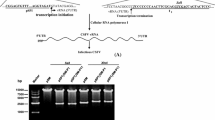Abstract
The complete nucleotide sequence of classical swine fever virus (CSFV) strain cF114 (F114 strain propagated on PK-15 cells) was cloned by RT-PCR. The analyses of nucleotide and amino acids identity between cF114 and F114, Brescia, Alfort or C strain were 99.41%, 96.80%, 86.03%, 95.70% and 99.28%, 98.54%, 93.33%, 97.41% respectively. The cDNA fragments with correct sequence were ligated into a full-length cDNA and inserted into pMC18 plasmid (pMC12297). A full-length infectious viral RNA was synthesized by runoff transcription and transfected to PK15 cells. Viruses were recovered from transfected cells which wese titrated on PK-15 cells by endpoint dilution and indirect immunofluorescence with a CSFV-specific monoclonal antibody. The antigenicity and replication kinetics of the plasmid-derived virus (vM12297) were similar to the parental virusin vitro. TheE01 orE2 gene was replaced with the genes from strain C and the pM/CE01 and pM/CE2 with chimeric full-length cDNA of cF114 were generated. The infectious viruses were obtained from pM/CE01 and pM/CE2. Both of the chimeric viruses can infect PK-15, SK-6 and primary testicle cell of swine. The chimeric viruses can grow to a titer of 8×105 F-PFU/mL. These results are very important for understanding the genes related to the CSFV propagation and pathogenesis.
Similar content being viewed by others
References
Regenmortel, M. H. V., Fauquet, C. M., Bishop, D. H. L. et al., The Seventh Report of the International Committee on Taxonomy of Viruses, 1st ed., San Diego: Academic Press, 2000, 859–878.
Thiel, H. J., Stark, R., Weiland, E. et al., Hog cholera virus: molecular composition of virions from a pestivirus, J. Virol., 1991, 65: 4705–4712.
Moormann, R. J. M., Gennip, H. G. P., Miedema, G. K. W. et al., Infectious RNA transcribed from an engineered full-length cDNA template of the genome of a pestivirus, J. Virol., 1996, 70: 763–770.
Ruggli, N., Tratschin, J., Mittelholzer, C. et al., Nucleotide sequence of classical swine fever virus strain Alfort/187 and transcription of infectious RNA from stably cloned full-length cDNA, J. Virol., 1996, 70: 3478–3487.
Mose, C., Tratschin, J. D., Hofmann, M. A., A recombinant classical swine fever virus stably expresses a marker gene, J. Virol., 1998, 72: 5318–5322.
Schnell, M. J., Mebatsion, T., Conzelmann, K. K., Infectious rabies viruses from cloned cDNA, EMBO J., 1994, 13: 4195–4203.
Whelan, S. P. J., Ball, L. A., Barr, J. N. et al., Efficient recovery of infectious vesicular stomatitis virus entirely from cDNA clones, Proc. Natl. Acad. Sci. USA, 1995, 92: 8388–8392.
Garcin, D., Pelet, T., Calain, P. et al., A highly recombinogenic system for the recovery of infectious Sendai paramyxovirus from cDNA: generation of a novel copy-back non-defective interfering virus, EMBO J., 1995, 14: 6087–6094.
Hurrelbrink, R. J., Nestorowicz, A., McMinn, P. C., Characterization of infectious Murray Valley encephalitis virus derived from a stably cloned genome-length cDNA, J. Gen. Virol., 1999, 80: 3115–3125.
Major, M. E., Mihalik, K., Fernandez, J. et al., Long-term follow-up of Chimpanzees inoculated with the first infectious clone for hepatitis C virus, J. Virol., 1999, 73: 3317–3325.
Imada, T., Yamaguchi, S., Mase, M. et al., Avian nephritis virus (ANV) as a new member of the family Astroviridae and construction of infectious ANV cDNA, J. Virol., 2000, 74: 8487–8493.
Phillips, J. J., Chua, M. M., Lavi, E. et al., Pathogenesis of chimeric MHV4/MHV-A59 recombinant viruses: the murine Coronavirus spike protein is a major determinant of neurovirulence, J. Virol., 1999, 73: 7752–7760.
Peeters, B. P. H., Leeuw, O. S., Koch, G. et al., Rescue of Newcastle Disease Virus from cloned cDNA: evidence that cleavability of the fusion protein is a major determinant for virulence, J. Virol., 1999, 73: 5001–5009.
Zhou, P. C., Chen, J. G., Zhai, Z. H. et al., Study on the cloning and expression of E0 of CSFV, Microbiology (in Chinese), 2000, 27(3): 165–170.
Sambrook, F., Fritsch, E. F., Maniatis, T., Molecular Cloning: A Laboratory Manual, 2nd ed., New York: Cold Spring Harbor Laboratory Press, 1989, 401–417.
Wang, Z., Lu, Y., Ding, M. X., Study of characters of infectivity of CSFV C strain on primary bovine testicle cells, Virologica Sinica (in Chinese), 2000, 15(2): 170–179.
Huang, Q. H., Zhang, C. H., Wang, J. F. et al., Construction, sequencing and analysis of cDNA library of CSFV genome of Shi-men strain, Chinese Science Bulletin, 2000, (4): 367–369
Khromykh, A. A., Westaway, E. G., Completion of Kun** virus RNA sequence and recovery of an infectious RNA transcribed from stably cloned full-length cDNA, J. Virol., 1994, 68: 4580–4588.
Boyer, J., Haenni, A., Infectious transcripts and cDNA clones of RNA viruses, Virology, 1994, 198: 415–426.
Author information
Authors and Affiliations
Corresponding author
About this article
Cite this article
Nie, Y., Chen, J. & Ding, M. Sequencing and rescuing a highly virulent classical swine fever virus: Chinese strain cF114 from a full-length cDNA clone. Chin.Sci.Bull. 48, 1124–1128 (2003). https://doi.org/10.1007/BF03185766
Received:
Accepted:
Issue Date:
DOI: https://doi.org/10.1007/BF03185766




